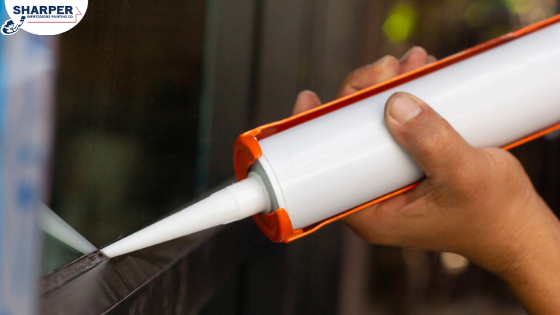We will never get tired of promoting the importance of meticulous preparation before every painting job. Painstaking prep is important on an exterior painting project since the paint job is exposed to the elements and fluctuations in temperature. Many people understand why they should pressure wash, scrape old paint and prime before repainting an exterior, but it’s usually the professionals who will preach about the importance of exterior caulking and sealing before painting as well.
Exterior Caulking Before Painting: Why Is It Important
What is caulking?
Caulking is a compound that is specifically designed to seal cracks, fill holes, gaps and joints in surfaces.
Caulk is typically applied with a caulking gun. When it’s applied well and is the right kind of caulk for the project, it will blend seamlessly into the area. Old, cracked or weathered caulk should always be removed and replaced.
Why is it important to use exterior caulk before painting?
Caulk is important for an exterior to extend the life of your paint job, but also to protect and insulate your home.
Here are a few other reasons exterior caulk is important:
- To prevent water from entering the home at joints or around windows
- To prevent insects from entering the home or infiltrating between walls and joints
- To help insulate the home from wind, extreme cold or extreme heat
- To keep water and moisture out of nail holes (water will settle in these holes and can cause rust and wood rot)
- To prevent condensation build up
- To improve the final appearance of the paint job (e.g. no visible holes or cracks)
What is the process for exterior caulk?
A reputable and professional paint company will always follow these steps when painting your exterior:
1. Buy The Best Caulk
Painters caulk is not very expensive at just a couple dollars per tube. When choosing between a 10, 20, 30 and 40 year warrantied caulk, invest in the best. The better tubes of caulk have more flexibility and more solid compounds so that the stretch and body of the caulk lasts longer than the cheaper tubes.
2. Clean the exterior where you are going to caulk
This step can include, but is not limited to, scraping or removing old paint, sanding or removing dirt/dust/soil or other types of build up and removing old caulk that is brittle and falling out.
3. Caulk repaired or replaced rotted wood
A good painting company will be sure to include repair requests in your overall exterior painting quote and will always include caulking around new or repaired wood. This is an extremely important step that should never be skipped. This could include applying caulking, patching or bondo to exterior wood that has been repaired due to wet or dry rot.
4. Prime (if necessary)
Some specialty caulks may need a primer before paint is applied, but most caulking is paintable.
5. Caulk Dry Time
Caulk should dry before painting over it, otherwise it can cause new paint to crack and warp.
6. Types of Caulk
For caulk that will be painted over, a latex caulk should be used. For caulk around windows and door frames that will not be painted, a clear drying, silicone caulk should be used, which can never be painted.
A few final notes about exterior caulking
Nail head holes, particularly old ones that are beginning to rust, can be an eyesore or sometimes simply don’t align with a homeowner’s aesthetic. Ask your painting professional to bid out how much it will cost to fill all those holes before painting. The advantage to filling all these small holes is a beautifully finished look. Plus, caulking nail head holes helps prevent nail pops and rusting.
Always caulk fascia seams (the band under a roof edge) so the wood is more secure and wind and rain can’t seep in. Plus, once painted it looks smooth and finished with no gaps.
Always make sure door and window frames are caulked so you can prevent moisture and wind from coming in. Improperly caulked windows and doors might result in fogging or dew droplets and water damage to walls and trim.
Stucco cracks can be filled with special patching, compounds or caulking prior to painting so you get a smooth, crack-free finish after exterior stucco painting is complete.
Hardie plank butt-joints and corner trim areas should be caulked to seal up any exposed joints.
When you take special care with caulking siding before painting, you can count on your exterior paint job lasting longer. Be sure to work with a reputable and professional painting company in your area to complete this project!
Seek Expert Help When Painting and Caulking an Exterior
Our professional paint experts are ready to help you with exterior caulking and painting projects. We take great care to make sure your home will look beautiful for years to come. Contact us today for a free exterior painting quote.

